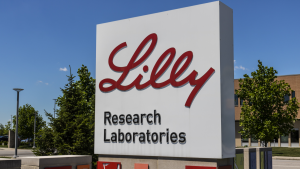
As 2024 unfolds, the spotlight falls on identifying the next trillion-dollar stocks. This elite club, currently consisting of six corporate giants at this time, symbolizes financial might, market influence, and innovative prowess.
The pursuit of such a monumental valuation underscores the inherent dynamism and expansion of the U.S. economy. With a landscape ripe for growth, certain companies emerge as frontrunners, each poised to join the ranks trillion-dollar stocks.
These potential candidates showcase a blend of robust financials, market leadership, and strategic vision, making them prime subjects of investor attention.
Meta Platforms (META)

Meta Platforms (NASDAQ: META) easily could be the next of the trillion-dollar stocks. It prioritized efficiency this year, which paid many dividends.
Its stock is up a whopping 172% year-to-date and has been killing it with its quarterlies by considerable margins across both lines. In its most recent quarter, the company registered a robust 23% year-over-year revenue surge, posting $34.1 billion.
This financial prowess was shown by a staggering 168% increase in diluted earnings per share, clocking in at $4.39.
Demonstrating a superb 24% revenue increase alongside an 87% surge in operating profit, Meta’s Family of Apps segment stands as a true testament to Meta’s strategic acumen.
The company’s primary revenue generator, its advertising sector, soared by an incredible 23% to $33.6 billion. This growth stems from Meta’s ability to effectively leverage its vast user base while honing its cost profile.
Currently valued at a market cap of $841 billion, Meta Platforms is on a clear path to breach the trillion-dollar threshold in 2024.
Visa (V)

Visa (NYSE: V) is another of the likely trillion-dollar stocks. It’s an unparalleled leader in issuing credit and debit cards, maintaining a powerful presence in fintech.
The company’s financial health remains enviable, showcasing profit margins between 45% to 50% of sales. Moreover, as consumer reliance on credit and debit cards persists, Visa remains poised to reward its long-term investors.
It has grown its payouts for a whopping 15 consecutive years, with a 16.3% growth over the past five years. The stock is up 23% year-to-date, and over the past five years, the stock has delivered over an 87% return.
Closing the fiscal year on a high note, Visa reported stable payment volumes and growth in transaction volumes, remaining unfazed by the rising cost of living. The company’s third-quarter financials demonstrate its resilience, with $8.6 billion in net sales and a remarkable 11% YoY increase in payment volume.
Net income soared to $17.2 billion, up 15% from the previous year. Given the upcoming holiday season, expectations for Visa’s performance in the fourth quarter remain high, potentially setting the stage for even more impressive results.
Broadcom (AVGO)

Broadcom (NASDAQ:AVGO) is a leading designer in the semiconductor space. It recently made a significant move with its recent acquisition of VMWare, a software services business specializing in cybersecurity and cloud computing. This merger is set to bolster Broadcom’s capabilities in private and multi-cloud environments, marking a major step forward in its market positioning.
The acquisition of VMware, now approved, opens doors to new opportunities, specifically in cloud infrastructure, a sector that is evolving in importance and relevance. Both firms aim for steady, sustainable top-line growth while improving their bottom-line results. This approach, prioritizing long-term financial health over short-term surges, positions them as reliable long-term players in their respective sectors. Moreover, with its dominant position in semiconductor software and intellectual property and its expanding footprint in cloud infrastructure through the VMware acquisition, Broadcom could break past the trillion-dollar barrier next year.
UnitedHealth Group (UNH)

UnitedHealth Group (NYSE:UNH) is a standout performer in the healthcare stock market, exhibiting remarkable resilience and growth. The company has been prodding along nicely, adding a nifty 12% gain in its stock in the past six months on the back of a pertinent merger. Moreover, its financial strength is evident in its most recent quarter, where UNH reported a substantial 14% increase in sales, reaching $92.4 billion, along with a parallel increase in operating earnings to $8.5 billion. UNH has successfully integrated nearly 700,000 consumers into its commercial benefits services, while its senior and community care offerings have attracted more than 40,000 new individuals.
Furthermore, in a pivotal move for UNH, it acquired Amedisys in a $3.3 billion deal, which is a leading provider of in-home health and hospice care. With an aging population, Amedisys, along with LHC Group, another home health provider acquired by UnitedHealth, is poised to cater to a burgeoning customer base. If UNH’s merger and acq isition activity continues at this pace and its financials continue firing, expect the firm to stock to crack the trillion dollar mark soon.
Eli Lilly (LLY)

Pharmaceutical giant Eli Lilly (NYSE:LLY) is poised for massive growth following the U.S. Food and Drug Administration (FDA) approval of its revolutionary weight loss drug. This new medication, previously marketed as a diabetes treatment under the name Mounjaro, will now be called Zepbound. Zepbound enters the market as a direct competitor to Novo Nordisk’s Ozempic, with an attractive pricing strategy, offering a more accessible option for consumers. The drug’s efficacy was already hinted at before FDA approval, with Mounjaro achieving substantial sales as doctors prescribed it off-label for weight loss. Demonstrating this success, Eli Lilly reported in its recent third-quarter earnings that Mounjaro sales skyrocketed to $1 billion, a tenfold increase from the prior-year period. LLY’s stock performance has effectively mirrored this optimistic outlook, having surged 61% this year. With Zepbound set to offer a compelling alternative to Ozempic, the development not only fortifies Eli Lilly’s position in the pharmaceutical industry but highlights its long-term potential for continued growth.
Taiwan Semiconductor Manufacturing (TSM)

Taiwan Semiconductor Manufacturing (NYSE:TSM) distinguishes itself as a contender to joining the trillion-dollar stocks.
With a commanding market share of over 56% in the global semiconductor foundry market, its role in advancing AI technology through superior chip manufacturing underlines its pivotal position as one of the hottest stocks to own.
TSMC’s financial strength is remarkable, with an A-rated profitability profile.
What sets the company apart from the competition is its commitment to long-term sustainability, aiming for 100% renewable energy use in all operations by 2040.
The company’s stock reflects this robustness, with a significant 33.4% rise year-to-date and an extraordinary 169% increase over five years. While there’s a way to go to hit a $1 trillion valuation, given the catalysts in motion, TSM stock is likely to hit that market within the next couple of years.
JPMorgan Chase (JPM)

JPMorgan Chase (NYSE:JPM) is the world’s largest bank, with a massive $4 trillion in assets under management.
It has navigated the tumultuous financial landscape with aplomb, with its third-quarter results showcasing resilience, surpassing Wall Street forecasts with ease. It reported an EPS of $4.33, which effortlessly topped the anticipated $3.95 analyst esimate.
Sales figures were equally impressive, totaling $40.69 billion, surpassing the expected $39.63 billion. This performance not only reflects a solid command over its operations but also a major 35% profit jump from the previous year.
Despite a temporary pause in its dividend hike in 2022, JPMorgan has maintained its commitment to dividend payments. This year, the firm has upped its quarterly dividend from $1 per share to $1.05 per share, marking a 5% increase.
The bank has raised its dividend for nine consecutive years, a clear sign of its unwavering commitment to delivering value to its shareholders. Hence, JPMorgan remains a beacon of stability and potential in the banking sector, making it a compelling choice for investors seeking long-term gains amidst a volatile economic climate.
On the date of publication, Muslim Farooque did not have (either directly or indirectly) any positions in the securities mentioned in this article. The opinions expressed in this article are those of the writer, subject to the InvestorPlace.com Publishing Guidelines






